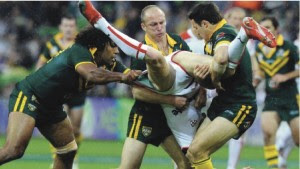Crikey i reckon its carked it mate!
Goodness i think it has died my friend!
Australian English is made up of slang and has many words that some consider unique to the language.The origins of these words are not clear and are often disputed.
Australian Language can be very funny and colourful, below are just a handful of words that Aussies use.
Ankle biter /Young child
Barbie /Barbecue
Billabong /Waterhole
Bruce /A man
Bunghole /Mouth
Chinnwag /A good chat
Chooks /Chicken
Cockie /Farmer
Coldie/ A cold beer
Crook /Sick or not functioning
Cruddy /Low quality
Dijeridu /Aboriginal musical wind instrument
Dipstick /Fool
Drongo /An idiot
Dunny /The toilet
Evo /Evening
Face fungus/A man's beard
Fair dinkum /Someone or something really genuine
Footy /Rugby League or Aussie Rules
G'day /Hi or Hello
Get Stuffed/ Go away!
Good on ya mate /Well done there, mate
Grog /Alcohol
Hard Yakka/ hard work
Holy-dooly /An expression of surprise
Iffy /Something questionable
Jackaroo, Jillaroo /Trainee male or female cattle station hand
Jarmies /Pyjamas
Kafuffle /Argument
Liquid amber/ Beer
Mate /Friend
Narkie /Short-tempered
Never Never /Mythical place in the outback
Nong /Idiot
No worries, mate /Don't worry about it
Ocker /Aussie who likes beer, sport and women
Oldies /Parents
Oz /Australia
Pommy, Pom /English person
Prang /Vehicle crash
Prezzies /Gifts
Quack /Doctor
Ripper! /Great!
Rip snorter! /Something really great
Saltie /Saltwater crocodile
Sandgroper /Someone from Western Australia
Sangas /Sandwiches
Sheila /Young woman
Smoko/Morning Tea
Snags /Sausages
Stralian /Australian
Stubby /Small bottle of beer
Tinnie /Can of cold beer
Toey /Very nervous person or in need of a partner
Top-ender /Someone from Northern Territory
True Blue /Really
Australian Tucker/ Food
Underdaks /Underpants
Uni /University
Veggies /Vegetables
Waterhole /Pub or hotel
Woomera /Stick used by Aborigines to throw spears
Wowser /Old-fashioned, prudish
Yabbie /Freshwater Australian crayfish
Yam /Fictional story
Zonked /Really tired
ZZZs /Get some sleep
These are just a handful of Australian language or slang words, if you no more please leave them in the comment box below.























































